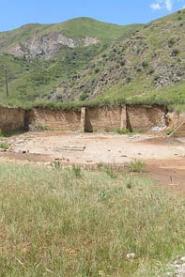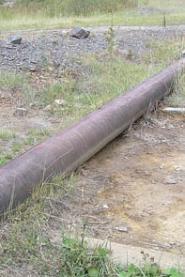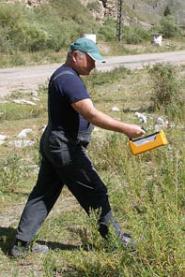PROJECT OUTLINE AND METHODS OF INVESTIGATION
The survey involved geophysical measurements combined with geochemical sampling and analysis of several components of the environment. The objective of the work was to define the areal extent and level of anthropogenic contamination caused by the mining and mineral processing complex of Ak-Tyuz and the impacts of the catastrophic failure of the dam of tailings pond No.2 that occurred in 1984. Dosimetry. This method was used continuously during the field operations and at all sampling sites where stream sediments and samples of industrial residues were collected. The method was also applied to soil samples taken on several profiles. The instrument used was an EXPLORANIUM Company, model GR 130, and measurements were made at two- second intervals, measurements being recorded as units of uR/hr. Gamma spectrometry. This method followed the dosimetric measurements using the GR 130 instrument (time of measurements 300 seconds). Contents of Th (ppm), U (ppm), K (%) and total gamma activity were established. Magnetic susceptibility measurements were applied as a supplementary method to establish susceptibility in soils and stream sediments. The tailings from ore treatment processes are rich in magnetite that is reflected in enhanced magnetic susceptibility. Consequently, remains of tailings in the Kichi-Kemin river valley can be detected using magnetic susceptibility as well as by conventional radiometry. A kappameter KT 9 produced by the Canadian Company EXPLORANIUM was used for the field measurements. The recorded value of magnetic susceptibility was based on an average of 5 measurements at a site 1 m in diameter. Stream sediments. Samples were collected from the river Kichi-Kemin and its tributaries, the sampling interval was ca 500 m. Fine muddy-clayey sediment of a mass of ca 1-1.5 kg was sampled whenever possible.
Summary of samples collected and methods of analysis used:
|
Type of sample |
Collected 2004 |
Collected 2005 |
Type of analysis |
Laboratory |
Total samples |
|
Stream sediments |
43 |
180 |
ICP-AES: 33 elements |
ČEL Kara-Balta, KG |
223 |
|
y-spectrometry: Th, U, K, Cs |
EXPLORANIUM CZ s.r.o |
||||
|
Magnetic susceptibility |
AGICO s.r.o. Brno |
||||
|
Soil samples |
38 |
400 |
ICP-AES: 33 elements |
ČEL Kara-Balta, KG |
438 |
|
y-spectrometry: Th, U, K, Cs |
ČEL Kara-Balta, KG |
||||
|
Heavy mineral concentrates |
24 |
31 |
Semi-quantitative mineralogical analyses |
GEOMIN cooperative |
55 |
|
Adioactivity od fractions: Th, U |
EXPLORANIUM CZ |
||||
|
ICP-MS: fine fraction: 42 elements |
ACME Laboratories, Kanada |
||||
|
Technological samples |
6 |
20 |
ICP-AES: 33 elements |
ČEL Kara-Balta, KG |
26 |
|
y-spectrometry: Th, U, K, Cs |
ČEL Kara-Balta, KG |
||||
|
Water samples |
10 |
20 |
ICP-AES: 33 elements |
ČEL Kara-Balta, KG |
30 |
|
Radioaktivita |
ČEL Kara-Balta, KG |







